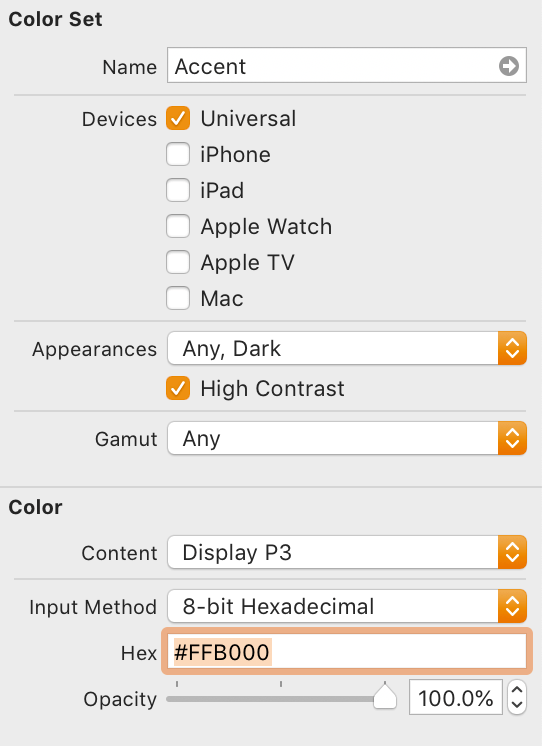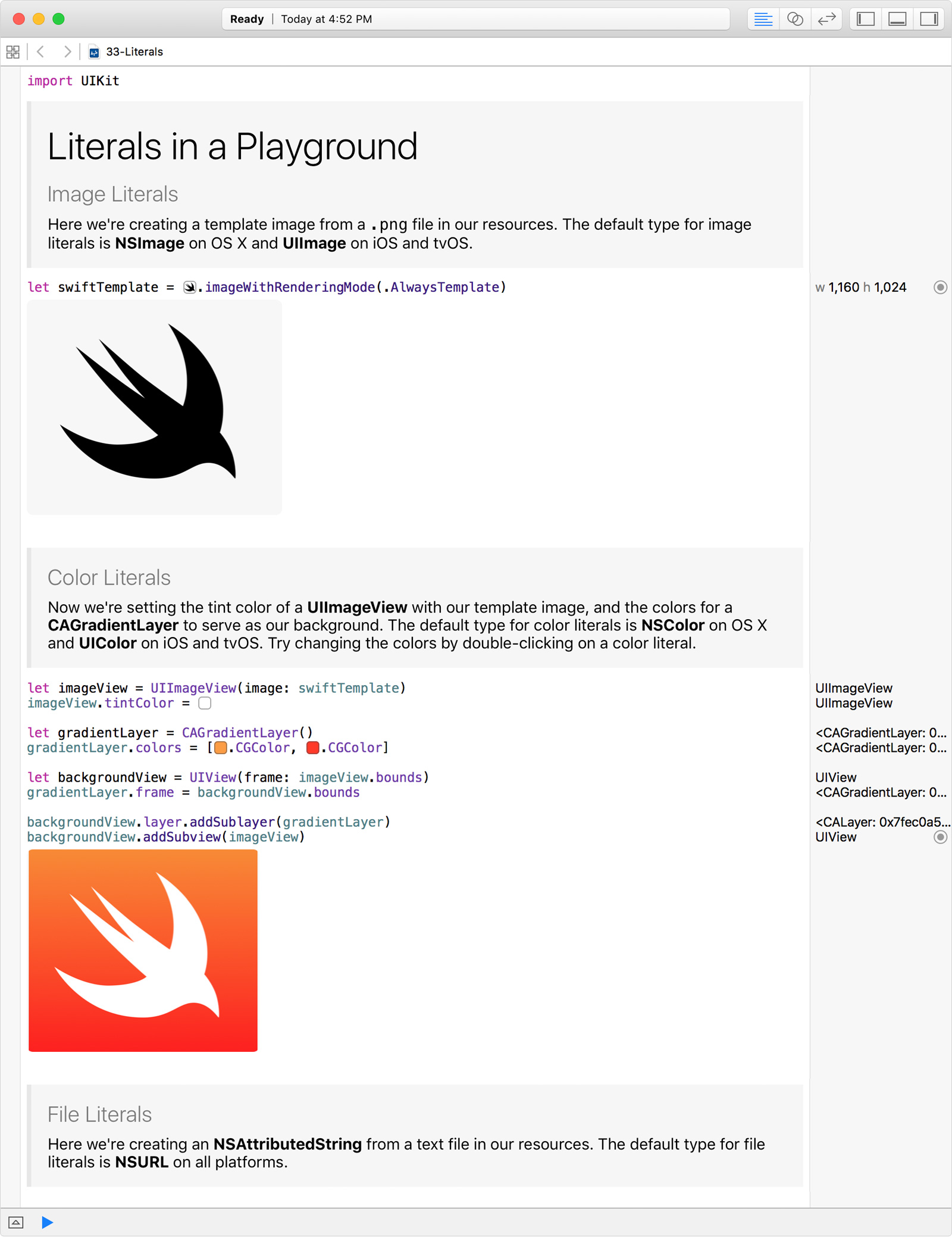- Literal Creator For Xcode Tutorial
- Literal Creator For Xcode Free
- Literal Creator For Xcode Editor
- Literal Creator For Xcode Windows
- Literal Creator For Xcode Mac
- Literal Creator For Xcode Download
- Literal Creator For Xcode Online
A 'literal' refers to any value which can be written out directly in source code. For example, 'hello' is a character literal and 32 is a integer literal. In the past Objective-C hasn't had support for defining literals, but as of Xcode 4.5 this is supported. The new syntax is also backwards compatible with older versions of iOS. Let's look at some NSNumber Objects.
[objc]NSNumber *celcius = [NSNumber numberWithInt:21]; NSNumber *pi = [NSNumber numberWithDouble:3.14159265359];[/objc]
With literals the new syntax will be.
[objc]NSNumber *celcius = @21; NSNumber *pi = @3.14159265359;[/objc]
Xcode has the ability to embed colors directly in code. These colors are called Color Literal and allows you to use a GUI for editing the colors quickly using preset colors or the Mac color picker. We'll also learn how to create a Gradient and use an Overlay modifier to float an element on top. Unlike dictionary With Objects And Keys: and other initializers, dictionary literals specify entries in key-value order. You should not terminate the list of objects with nil when using this literal syntax, and in fact nil is an invalid value. For more information about object literals in Objective-C, see Working with Objects in Programming with Objective-C.
Object literals are very useful and they often make your code easier to read and understand. String literals are a bit different, though. It is true that a string literal is the easiest solution to create a `String` object. It is straightforward and everyone understands what is going on. But there is a price you pay every time you use a string literal. ValueError: invalid literal for int with base 10: 'largeDoses' 猫不理狗子.: 谢谢(´-ω-`) opencv 伪彩色和彩虹图. Cccpru: 自己做mlx90640的热成像,参考了下,很好用 opencv 多线程显示imshow出现图片不更新的问题. Tisfy: Nice!,古人云:出师未捷身先死,长使英雄泪满襟。. A playground literal is used by Xcode to create an interactive representation of a color, file, or image within the program editor. Playground literals in plain text outside of Xcode are represented using a special literal syntax. For information on using playground literals in Xcode, see Add a color, file, or image literal in Xcode Help.
The syntax in Arrays is also much simpler, let's look at an example of some arrays
[objc]NSArray *randomNumbers = [NSArray arrayWithObjects: [NSNumber numberWithFloat:-273.15, [NSNumber numberWithInt:90210], nil];
NSArray *names = [NSArray arrayWithObjects: @'Alex Smith', @'John Williams', nil];[/objc]

With literals everything between @[ ] becomes an item in an NSArray. Also , there's no need for a terminating nil sentinel. So you can write
[objc]NSArray *randomNumbers = @[ @-273.15, @90210]; NSArray *names = @[ @'Alex Smith', @'John Williams'];[/objc]
Let's look at dictionaries, first the original syntax.
[objc]NSDictionary *nameDictionary = [NSDictionary dictionaryWithObjectandKeys: firstName, @'Alex', lastName, @'Smith', nil];[/objc]
Dictionaries will have a similar syntax, everything between @{ } becomes an key-object pair. Note that ther order has changed in value,key.
[objc][NSDictionary *nameDictionary = @{ @'Alex' : firstName, @'Smith' : lastName};[/objc]
The preceding literal syntax @[ ] and @{ } create immutable objects. To make mutable objexts you have to call mutableCopy.
[objc]NSArray *names = [@[ @'Alex Smith', @'John Williams'] mutableCopy];
NSDictionary *nameDictionary = [@{ @'Alex' : firstName, @'Smith' : lastName} mutableCopy];[/objc]
That's it, as you can see the new literal syntax is much cleaner and simpler.
Literal Creator For Xcode Tutorial
Download Your Free Copy ofThe
Literal Creator For Xcode Free
Missing Manualfor Swift Development
The Guide I Wish I Had When I Started Out
Join 20,000+ Developers Learning About Swift Development
Download Your Free CopyObject literals are very useful and they often make your code easier to read and understand. String literals are a bit different, though. It is true that a string literal is the easiest solution to create a String object. It is straightforward and everyone understands what is going on. But there is a price you pay every time you use a string literal. Did you know that?
Common Examples

Let me show you a few common examples of string literals as they are used in Swift and Cocoa development.
I bet these examples look familiar. In each example, we use one or more string literals to carry out a task. What is wrong with these examples?
While there is nothing inherently wrong with the use of string literals, there is room for improvement. String literals very often lead to stringly typed code, a play on strongly typed.
What Is Stringly Typed Code
When strings, and very often string literals, are used instead of a more appropriate type, we speak of stringly typed code. Some forms of stringly typing are obvious while others are more subtle. This is an obvious example of stringly typed code.
When working with coordinates, there is a better solution than using strings for the location's latitude and longitude. This is a better implementation that adds safety and clarity.
We can take it one step further by asking the Core Location framework for help.
Another obvious example is the use of a String object instead of a URL object. There is a reason why Apple pushes APIs that accept a URL object instead of a path, that is, a String object.
Subtle Forms of Stringly Typed Code

There are many subtle forms of stringly typed code that are often overlooked. These forms are easy to avoid with a tiny amount of refactoring. Let me show you how I get rid of the string literals in the examples I showed you earlier.

Images

Whenever I use an API that accepts a String object, I am on my guard. Why? It is an opportunity for a string literal to make its way into my codebase. This is a very common example.
Literal Creator For Xcode Editor
This is how the majority of developers create UIImage instances. The UIImage class explicitly asks for a String instance. What is wrong with this and how can we improve this example?
Let me ask you a few questions first. What happens if the asset's name changes? And what happens if you misspell the asset's name? Because init(named:) returns an optional UIImage instance, the compiler won't warn you if there isn't an asset with the name you passed to init(named:). How can we solve this problem?
There are several solutions. I usually create an extension for UIImage that looks something like this.
Does this look overly complex to you? I can understand that it may look too complex of a solution for the problem. Bear with me, though. This solution makes clever use of enumerations to create namespaces. It is a pattern I use very, very often and it is one of the patterns I swear by.
Literal Creator For Xcode Windows
The resulting API looks and feels elegant and intuitive. Don't you agree? This is what it looks like at the call site.
Notice that I use an exclamation mark in the UIImage extension to forced unwrap the result of init(named:). As I write elsewhere, I rarely use Swift's exclamation mark. One exception is the loading of assets and resources from the application's bundle. Such an operation should never fail. If it fails, then I have other things to worry about and the application crashing due to a runtime error is the least of my worries.
You may be wondering if instantiating a UIImage instance in an extension is a wise thing to do. Don't worry, though. Static properties like this are instantiated lazily. That is obviously a good thing since we want to load an asset the moment it is needed. This improves performance and reduces memory consumption.
If you are worried about memory consumption, then you can turn the static constant property into a static computed property.
Storyboards
Literal Creator For Xcode Mac
I use a similar solution for loading storyboards and instantiating the view controllers they contain. I create an extension for UIStoryboard and define a static constant property.
It is important to realize that the storyboard is kept in memory for the lifetime of the application once it is instantiated. If that isn't what you want, then you can turn the static constant property into a static computed property.
A new instance of the storyboard is created every time the main computed property is accessed. You can use a similar strategy for the view controllers of a storyboard. Take a look at the following example and notice the use of the exclamation mark.
An added benefit is that the pattern makes the instantiation of the OnboardingViewController class more concise at the call site.
This is much better than the alternative, especially if you need to instantiate the view controller in multiple locations.
Localization
You can use a similar strategy for localization. It is unfortunate that Apple doesn't add support for this in Xcode. I would be nice to take advantage of autocompletion when localizing an application.
Segues
The last example that is worth mentioning is the use of segues. The approach I am currently using is simple yet effective. I define a private enum, Segue, in the view controller. For every segue of the view controller, I define a static constant property. This means I no longer need to deal with string literals or constant stored properties.
What Do We Gain
The Xcode theme I use highlights string literals in bright red. It shows me an overview of the string literals I am using and, when I see too much red, it is time for some refactoring.
But you may be wondering why this is necessary. I hope I have convinced you that the use of string literals can break your application without the compiler warning you about it. That is the inherent risk of string literals and stringly typed code.
The solutions I listed come with a few key benefits. You can take advantage of Xcode's autocompletion and, more important, the compiler helps you find common bugs that are the result of typos. Refactoring also becomes easier and less prone to errors. You don't need to rely on search and replace to update the project.
Automation
Even if you use the solutions I listed, you still need to be careful. For example, you need to make sure that the identifier of a segue matches the one you use in your codebase and that is where automation can prove very useful.
There are several libraries and frameworks that automatically generate the extensions I showed you. The code generation usually takes place at compile time. This means that you eliminate typos, benefit from code completion, and, when you make a change, it is automatically propagated.
I don't use any of these solutions, but I have to admit that it is tempting if you care about safety and consistency. To be honest, I believe it is Xcode's responsibility to handle such tasks. Many popular IDEs do.
Loading an image from an asset catalog, for example, should be easier and less prone to errors. It shouldn't involve string literals if the image is included in the application bundle. It could look something like this.
Download Your Free Copy ofThe Missing Manual
for Swift
Literal Creator For Xcode Download
DevelopmentThe Guide I Wish I Had When I Started Out
Literal Creator For Xcode Online
Join 20,000+ Developers Learning About Swift Development
Download Your Free Copy